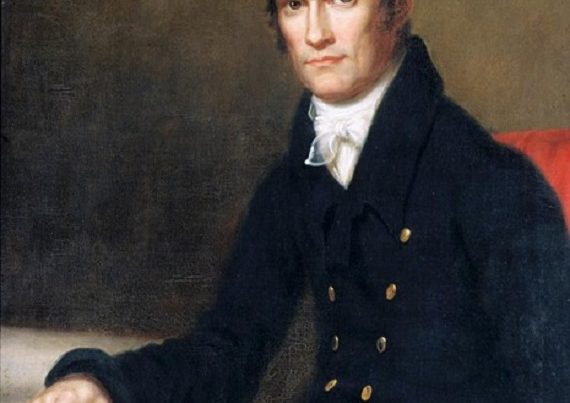In an era in which serious concerns are discussed regarding police abuse, government surveillance, standing armies, increasing division and strife and the potential loss of constitutional rights, American Bastille details the accounts of the imprisonment and sufferings of approximately 70 people at the hands of the State (including pastors, Judges, U.S. Senators, Doctors, Farmers, Editors, Foreign Ministers and women) from places like New York, Pennsylvania, Illinois, California, Iowa, Missouri, Kentucky, Maryland, Indiana and Ohio. Marshall writes that their stories have been preserved “for the purpose of preventing, in the future, a repetition of the errors and crimes committed in the past, and to aid in the preservation of those rights, liberties, and franchises transmitted to us by the fathers of the Republic, to be protected, defended, and guarded by us, as a sacred trust.”
The illustration featured at the beginning of this piece (and as seen in the book) visually tells a powerful story of the sad abuses visited upon American citizens by their government. In the center, the hand of Secretary Seward (of the U.S. State Department) receives an order for the arrest of a citizen. Meanwhile, the upper left corner features the arrest of a victim in his bed, the upper right has the same citizen being taken by armed guard to the place of his imprisonment. The lower right features the emaciated victim sitting in prison, while in the lower left corner Liberty in shackles weeps. Below the illustration are the words of Secretary Seward to Lord Lyons, in which he states, “My Lord, I can touch a bell on my right hand, and order the arrest of a citizen of Ohio; I can touch a bell again, and order the imprisonment of a citizen in New York; and no power on earth, except that of the President, can release them. Can the Queen of England do so much?”
Regarding an out-of-control Lincoln administration and Federal military, which would pave the way for later violations against the American people, Marshall notes an interesting quote from the great William Blackstone, “To bereave a man of his life, or by violence to confiscate his estate, without accusation or trial, would be so gross and notorious an act of despotism as must at once convey the alarm of tyranny throughout the whole kingdom; but confinement of the person, by secretly hurrying him to jail, where his sufferings are unknown or forgotten, is a less public, a less striking, and therefore a more dangerous engine of arbitrary power.” But of course Blackstone, an eighteenth century jurist, judge and politician from England who was once well known even in the States for his Commentaries on the Laws of England, has long since fallen from legal fashion for his views on natural law and individual liberty. Sadly, the same can perhaps be said for Marshall’s view that, “Everything appertaining to the history of our country – her institution – the sovereignty of her people – her liberties – her progress, and her destiny – must necessarily interest the American citizen. The liberty of the citizen is the great prop of Free Government.”
Below are a handful of summarized accounts from American Bastille:
Reminiscent of the “witch-hunts” of old, or the feared secret polices of Communist Russia or Nazi Germany (in more recent history), General William Brindle was accused during Lincoln’s War of, “being a terror to Union men, and having arms in his house”. As such, he was quickly arrested on orders of General Blunt on July 28, 1862 in Lecompton, Kansas. Confined in “one of the most filthy prisons it is possible to conceive”, Brindle noted that his temporary lodgings was full of residents from the area who had also been dragged from their homes and imprisoned for weeks without any known cause. The sanitary conditions of the prison were totally neglected, with an overpowering stench from the accumulated filth on the floor. On July 30, he was later released. He received an honorable discharge and cancellation of his bond on August 26, 1862 by Major E.A. Calkins. Brindle later made known to the residents of Leavenworth that a large number of people were held by military authorities, and succeeded after great difficulty in obtaining their release. Also in neighboring Missouri of that same year, Mr. John W. Smith, an elderly Jewish inventor and merchant who was homeless and blind in one eye, and whose property was stolen out from under him by John Brown and Lane in Kansas, was arrested after his mail was searched. It was determined by authorities that he might be conspiring against the Federal government. Sent to the Old Capitol Prison, he was stripped nude, and searched for evidence of the charge made against him – but nothing was found. Regardless, he was kept locked up for two months and punished without trial or judgment. The same kinds of Constitutional abuses would happen on a much larger scale in Columbia County, Pennsylvania, when a Federal military force descended upon the region in 1864. Such a massive expenditure of resources and manpower was simply due to a mere suspicion of “rebellion” in the area. Numerous citizens were arrested, with around 44 men of varying ages (the oldest was 68) incarcerated for varying lengths in dark and damp conditions at Fort Mifflin – the majority of them confined without trial. However, it was soon determined that any rebellion was a “farce”. Still, one of the prisoners, William E. Roberts, died in prison.
Meanwhile, for helping provide care to the persecuted political enemies of the State, Dr. John T. Gilmer of Adams County, Illinois was seized in the summer of 1863 and thrown in jail. After being released, he sadly died from a stroke of apoplexy induced by his imprisonment. And in 1864, Mrs. Mary B. Morris of Chicago, Illinois found herself in trouble over providing care in the form of clothing and food for the sick and wounded housed in the Camp Douglas prison. In the middle of the night, around 50 Federal soldiers surrounded her and her husband’s home, and her husband was hauled off to prison. Four weeks later, her house was ransacked by Federal troops and she was hauled off to jail as well. For months, she was housed in a dirty and cold cell – but was eventually released.
Perhaps providing inspiration for the next 160 years of Police-statism in America, Rev. David R. McAnally of St. Louis notes how in July of 1861, a company of 44 Federal soldiers under orders from their headquarters kidnapped him and proceeded to turn his home and office upside down. They “ransacked it from cellar to garret. What they expected to find, or were looking for, I never asked, I never knew. Nor to the ransacking of my editorial office; the destruction of my private papers, which was done in April, 1862, when I was absent; nor to the almost numberless unlawful and unjust indignities, disabilities, etc., that were put upon me during the three years and more that I was a prisoner. Nor yet have I alluded to the horrible outrages, cruelties, and barbarities which I saw practiced on helpless prisoners, and for no reason whatever.” And on March 25, 1862, Thomas W. Berry of Prince George County, Maryland was arrested and threatened with hanging. Earlier he claimed his home had been invaded by soldiers and was mutilated. A party of them even broke into the family grave, “tearing the silver-plated handles and screws from the coffin which contained the ashes of his father; while the coffins of his infant brother and sister were broken open at the same time and their bones left lying on the floor of the vault.” He was later discharged on April 12, 1862.
Additionally during the war years, it seems that Federal authorities weren’t above taking civilian hostages or human shields, as on August of 1861, Rev. Henry M. Paynter of Booneville, Missouri was arrested along with five other citizens (including a cashier of the bank, a physician, a lawyer, a retired merchant and a druggist). They eventually learned that their captors had no charges against them, but as the Federal soldiers stationed in Boonville anticipated an attack by the rebels, they needed influential hostages. The commander noted that if “their friends desired to save their lives, they must find out where the enemy was, and keep him away; for if an attack was made upon him, he would put his prisoners up as targets, and if the conflict became severe, their lives should be the forfeit for the lives of his men.” Eventually there was an attack, and the Confederate Forces were forced to withdraw or the hostages would be sacrificed. A couple months later on October 2, 1861 in Maysville, Kentucky, 200 Federal soldiers marched into town and kidnapped Hon. Richard H. Stanton (a Prosecuting Attorney), James H. Hall (businessman), Washington B. Tottle (leading member of a mercantile firm), Benjamin F. Thomas (member of the B.F. & O.H.P Thomas firm), Wm. Hunt (tobacco merchant), Isaac Nelson (merchant), George Forrester (editor) and William T. Costoe (lawyer). The men were never appraised of any charges made against them, and were kept imprisoned in a cold wood plank enclosure for the whole month of October, and then transferred to Fort Lafayette for two months before being discharged without ever having been allowed a trial.
In conclusion, the author notes that, “No words we could use would bring relief to the harrowed feeling of, or redress of wrongs perpetrated upon thousands of unoffending citizens by their unwarranted incarceration in American Bastilles during the Administration of the late President Lincoln. We contemplate the cruelties, oppressions, persecutions, and imprisonments, committed during that long night of political despotism, with alarm. We shudder for the future of the country, when we take a retrospect of the late past.”
Prophetic? You decide.







